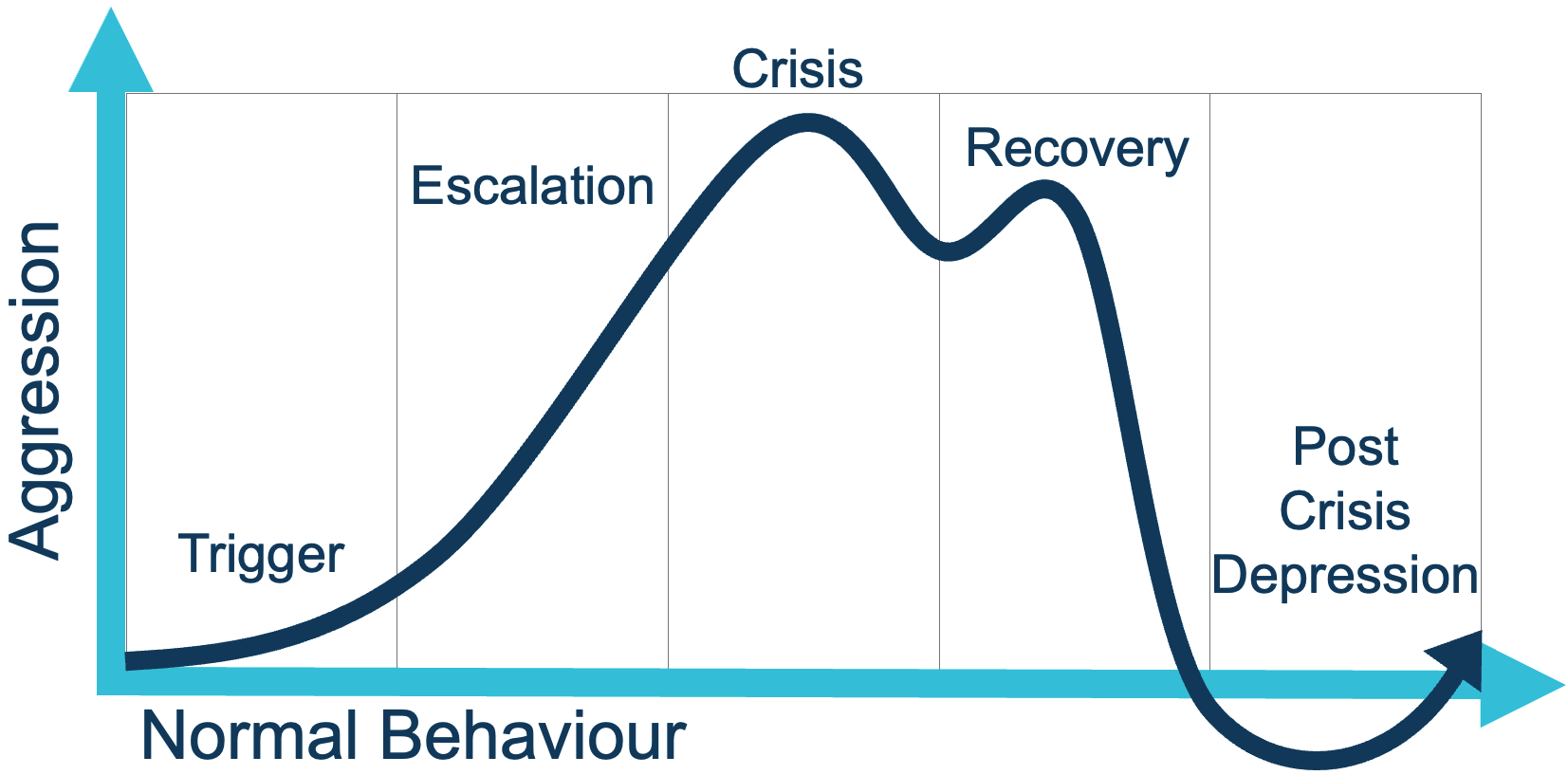The Assault Cycle
The Assault Cycle is a model used to describe the stages of escalating behaviour that may lead to aggression or violence. Understanding these stages can help educators, care workers, and other professionals recognise warning signs early and intervene effectively to de-escalate the situation.
This document explains the five stages of the assault cycle, the behaviours typically associated with each stage, and strategies to manage and de-escalate aggression at every step.
The Five Stages of the Assault Cycle

1: Trigger Phase
The trigger phase occurs when an individual is exposed to an event or stressor that initiates feelings of frustration, fear, or anxiety.
Behaviours:
- Signs of agitation, such as fidgeting or pacing.
- Verbal expressions of discomfort or dissatisfaction.
- Withdrawal from the situation.
De-escalation Strategies:
- Identify the Trigger: Observe and understand what is causing distress. Example: Noise levels, perceived unfairness, or unmet needs.
- Provide Support: Offer reassurance and address the trigger where possible. Example: “I can see this is upsetting you. Let’s talk about it.”
- Create a Calming Environment: Reduce stimuli, such as loud noises or distractions.
2: Escalation Phase
During this phase, the individual’s emotions and behaviours intensify as they struggle to manage their response to the trigger.
Behaviours:
- Increased restlessness or agitation.
- Raising voice or using aggressive language.
- Non-verbal signs such as clenched fists or rapid breathing.
De-escalation Strategies:
- Stay Calm: Use a calm tone and maintain a non-threatening posture. Example: Keep your voice low and avoid sudden movements.
- Set Boundaries: Clearly and respectfully communicate expectations. Example: “I need you to lower your voice so we can resolve this together.”
- Redirect Focus: Introduce a distraction or alternative task. Example: “Can we step outside for some fresh air while we discuss this?”
3: Crisis Phase
In the crisis phase, the individual may lose control, exhibiting aggressive or violent behaviour. This is the peak of the assault cycle.
Behaviours:
- Physical aggression (e.g., hitting, throwing objects).
- Verbal threats or shouting.
- Extreme emotional outbursts.
De-escalation Strategies:
- Prioritise Safety: Ensure the safety of everyone involved by creating space and, if necessary, removing others from the area.
- Avoid Confrontation: Do not argue, challenge, or escalate the situation further.
- Use Non-Physical Interventions: Maintain a safe distance and use verbal techniques to calm the individual. Example: “I’m here to help. Let’s find a way to make this better.”
- Call for Assistance: If the situation becomes dangerous, seek help from colleagues or emergency services.
4: Recovery Phase
After the crisis, the individual begins to regain control of their emotions and behaviour.
Behaviours:
- Physical exhaustion or withdrawal.
- Reduced aggression but lingering tension.
- Reluctance to engage in conversation.
De-escalation Strategies:
- Provide Space: Allow the individual time to calm down without feeling pressured. Example: “Take your time—I’m here when you’re ready to talk.”
- Monitor Their Well-Being: Check for any physical or emotional harm they may have experienced during the crisis.
- Avoid Blame: Focus on moving forward rather than criticising past behaviour.
5: Post-Crisis Depression Phase
The post-crisis phase involves reflecting on what happened and working to prevent similar incidents in the future.
Behaviours:
- Feelings of guilt, shame, or regret.
- Willingness to discuss the incident and explore solutions.
- Return to baseline behaviour.
De-escalation Strategies:
- Debrief with the Individual: Discuss the incident calmly and identify triggers or stressors. Example: “Can we talk about what happened and how we can handle it differently next time?”
- Develop a Plan: Create strategies to prevent future escalation, such as coping techniques or changes to routines.
- Reflect as a Team: Review the incident with colleagues to identify lessons learned and improve intervention practices.
Summary of the Assault Cycle
Stage
Behaviour
De-Escalation Focus
Trigger Phase
Agitation, verbal discomfort.
Identify and address the source of distress.
Escalation Phase
Intensifying agitation, raised voice.
Stay calm, set boundaries, and redirect focus.
Crisis Phase
Aggression, physical or verbal.
Prioritise safety, avoid confrontation, seek assistance.
Recovery Phase
Withdrawal, exhaustion.
Provide space, monitor well-being, and avoid blame.
Post-Crisis Depression Phase
Regret, baseline behaviour returns.
Debrief, reflect, and develop a plan for future prevention.
Why Understanding the Assault Cycle Matters
- Early Intervention: Recognising the signs of the trigger and escalation phases allows you to address the situation before it reaches a crisis.
- Improved Safety: Strategies tailored to each phase prioritise the safety of all involved.
- Focus on Prevention: The post-crisis phase provides an opportunity to reflect and implement strategies to reduce future incidents.
- Maintaining Dignity: Responding calmly and respectfully throughout the cycle helps preserve the dignity of the individual in distress.
Practical Tips for Managing the Assault Cycle
- Stay Self-Aware: Monitor your own emotions and avoid reacting impulsively.
- Be Consistent: Use clear communication and follow established protocols.
- Build Trust: Show empathy and understanding to foster a sense of safety and cooperation.
- Practise De-escalation Skills: Regular training in techniques such as active listening, non-verbal communication, and boundary setting enhances confidence and effectiveness.
Conclusion
The assault cycle provides a framework for understanding how behaviours escalate and how to respond effectively at each stage. By recognising the phases and implementing appropriate de-escalation strategies, you can manage challenging situations with confidence, ensuring the safety and dignity of everyone involved.
Mastering these techniques is essential for preventing conflicts, reducing the risk of harm, and fostering a supportive and respectful environment.
Version: Version: 1.07
